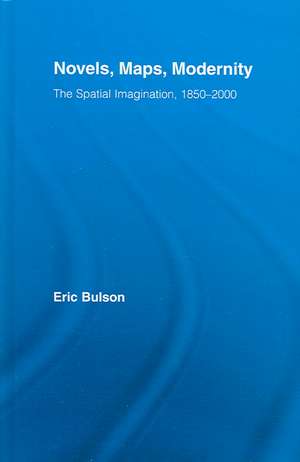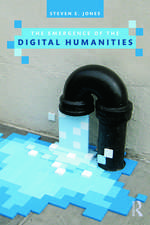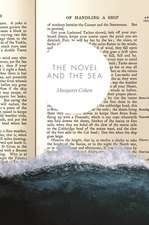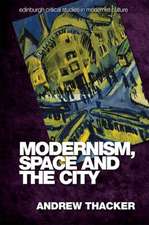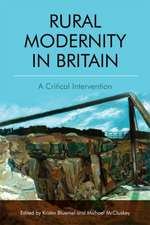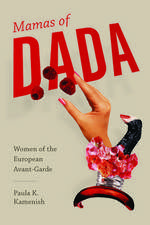Novels, Maps, Modernity: The Spatial Imagination, 1850–2000: Literary Criticism and Cultural Theory
Autor Eric Bulsonen Limba Engleză Hardback – 23 ian 2007
| Toate formatele și edițiile | Preț | Express |
|---|---|---|
| Paperback (1) | 424.58 lei 6-8 săpt. | |
| Taylor & Francis – 30 sep 2009 | 424.58 lei 6-8 săpt. | |
| Hardback (1) | 1106.81 lei 6-8 săpt. | |
| Taylor & Francis – 23 ian 2007 | 1106.81 lei 6-8 săpt. |
Din seria Literary Criticism and Cultural Theory
- 9%
 Preț: 935.20 lei
Preț: 935.20 lei - 9%
 Preț: 1037.81 lei
Preț: 1037.81 lei -
 Preț: 309.89 lei
Preț: 309.89 lei - 18%
 Preț: 1053.16 lei
Preț: 1053.16 lei - 18%
 Preț: 999.02 lei
Preț: 999.02 lei - 18%
 Preț: 1005.39 lei
Preț: 1005.39 lei - 18%
 Preț: 1102.88 lei
Preț: 1102.88 lei - 18%
 Preț: 1054.58 lei
Preț: 1054.58 lei - 18%
 Preț: 998.71 lei
Preț: 998.71 lei - 18%
 Preț: 701.56 lei
Preț: 701.56 lei - 18%
 Preț: 1109.78 lei
Preț: 1109.78 lei - 18%
 Preț: 1054.61 lei
Preț: 1054.61 lei - 18%
 Preț: 1062.98 lei
Preț: 1062.98 lei - 18%
 Preț: 1051.55 lei
Preț: 1051.55 lei - 15%
 Preț: 697.34 lei
Preț: 697.34 lei - 18%
 Preț: 1050.16 lei
Preț: 1050.16 lei - 18%
 Preț: 998.08 lei
Preț: 998.08 lei - 26%
 Preț: 819.09 lei
Preț: 819.09 lei - 26%
 Preț: 766.12 lei
Preț: 766.12 lei - 18%
 Preț: 997.45 lei
Preț: 997.45 lei - 18%
 Preț: 998.26 lei
Preț: 998.26 lei - 28%
 Preț: 490.08 lei
Preț: 490.08 lei - 18%
 Preț: 998.88 lei
Preț: 998.88 lei - 18%
 Preț: 1109.18 lei
Preț: 1109.18 lei - 18%
 Preț: 1105.24 lei
Preț: 1105.24 lei - 31%
 Preț: 763.64 lei
Preț: 763.64 lei - 18%
 Preț: 1000.61 lei
Preț: 1000.61 lei - 18%
 Preț: 999.82 lei
Preț: 999.82 lei - 26%
 Preț: 819.48 lei
Preț: 819.48 lei - 26%
 Preț: 763.78 lei
Preț: 763.78 lei - 18%
 Preț: 779.28 lei
Preț: 779.28 lei - 17%
 Preț: 245.56 lei
Preț: 245.56 lei - 18%
 Preț: 998.56 lei
Preț: 998.56 lei - 26%
 Preț: 877.30 lei
Preț: 877.30 lei - 18%
 Preț: 999.46 lei
Preț: 999.46 lei - 26%
 Preț: 819.09 lei
Preț: 819.09 lei - 15%
 Preț: 673.44 lei
Preț: 673.44 lei -
 Preț: 365.54 lei
Preț: 365.54 lei - 18%
 Preț: 1052.35 lei
Preț: 1052.35 lei - 18%
 Preț: 1057.05 lei
Preț: 1057.05 lei - 18%
 Preț: 944.11 lei
Preț: 944.11 lei - 18%
 Preț: 1056.28 lei
Preț: 1056.28 lei - 26%
 Preț: 763.39 lei
Preț: 763.39 lei - 26%
 Preț: 819.09 lei
Preț: 819.09 lei - 31%
 Preț: 766.66 lei
Preț: 766.66 lei - 18%
 Preț: 997.45 lei
Preț: 997.45 lei - 26%
 Preț: 820.32 lei
Preț: 820.32 lei - 18%
 Preț: 731.71 lei
Preț: 731.71 lei - 18%
 Preț: 1002.36 lei
Preț: 1002.36 lei
Preț: 1106.81 lei
Preț vechi: 1349.76 lei
-18% Nou
Puncte Express: 1660
Preț estimativ în valută:
211.78€ • 221.12$ • 175.28£
211.78€ • 221.12$ • 175.28£
Carte tipărită la comandă
Livrare economică 04-18 aprilie
Preluare comenzi: 021 569.72.76
Specificații
ISBN-13: 9780415976480
ISBN-10: 0415976480
Pagini: 188
Ilustrații: 20 b/w images
Dimensiuni: 152 x 229 x 15 mm
Greutate: 0.39 kg
Ediția:1
Editura: Taylor & Francis
Colecția Routledge
Seria Literary Criticism and Cultural Theory
Locul publicării:Oxford, United Kingdom
ISBN-10: 0415976480
Pagini: 188
Ilustrații: 20 b/w images
Dimensiuni: 152 x 229 x 15 mm
Greutate: 0.39 kg
Ediția:1
Editura: Taylor & Francis
Colecția Routledge
Seria Literary Criticism and Cultural Theory
Locul publicării:Oxford, United Kingdom
Cuprins
List of Figures. Acknowledgements. Introduction: Orienting, Disorienting the Novel 1. On Getting Oriented 2. Melville’s Zig-Zag World-Circle 3. Joyce’s Geodesy 4. Pynchon’s Baedeker Trick 5. On Getting Lost Notes. Bibliography. Index
Recenzii
"Bulson has written a volume…that provides lucid and imaginative observations on the novelistic representation of place from the mid-nineteenth century works of Charles Dickens and Herman Melville to late twentieth-century fiction by Thomas Pynchon and W.G. Sebald. Bulson’s point of departure is the seldom acknowledged importance that documents of geographical orientation—most notably maps and guide books—have played in the writing, reading, and criticism of fiction. As a work of literary criticism, Novels, Maps, Modernity is well researched, provocative, and highly readable. Not only does it offer fresh readings of three of the most widely studied novels in the Anglo-American canon, but it provides new ways of looking at any novelistic representation of geographical place." –Jon Hegglund, Washington State University, Modern Philology
Descriere
Novels, Maps, Modernity argues that cartographic devices—including maps, sea charts, and aerial photographs—have radically shaped how novelistic space has been imagined and represented from the mid-nineteenth century to the end of the twentieth. More than an antidote to disorientation, Eric Bulson demonstrates that they conceal a more complex story about capitalism, urbanization, empire, and world war.
